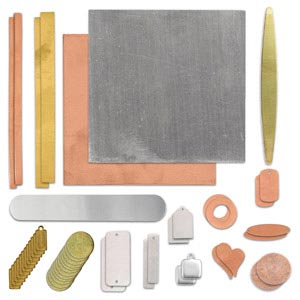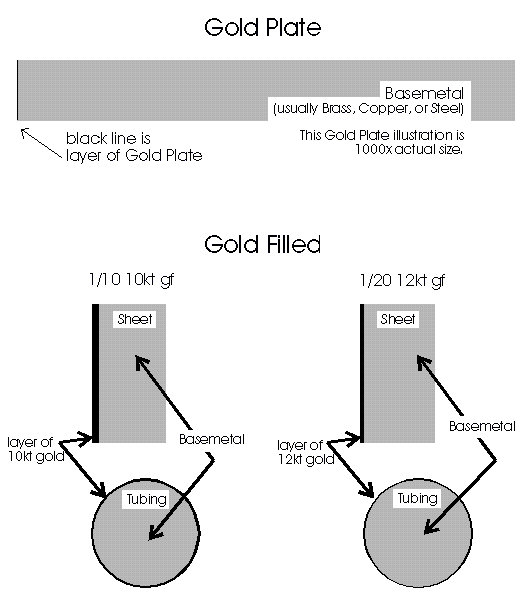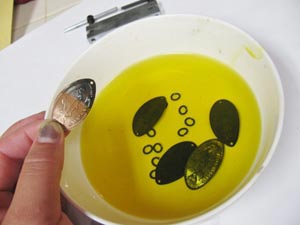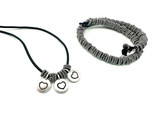Metals
Jump directly to illustration of gold-fill vs. gold plate.
What are Elements and Alloys? | ||||||||||||||||||||||||
 Metals can be elements or alloys. Elements are the basic building blocks of chemistry. Examples of elements: Oxygen, nitrogen, hydrogen, iron (Fe), copper (Cu) and niobium (Nb). Metals can be elements or alloys. Elements are the basic building blocks of chemistry. Examples of elements: Oxygen, nitrogen, hydrogen, iron (Fe), copper (Cu) and niobium (Nb).Lead (Pb) is an element that was popular for 1,000's of years as an ingredient in casting alloys (and some other alloys) because it makes some metals softer, less brittle and/or helps them melt at lower temperatures. Lead is now known to be related to certain cognitive and health problems (especially in children), and most governments are regulating allowable amounts of lead in jewelry components, due to the dangers of children swallowing beads or other parts of their jewelry. Jewelry components containing lead are generally considered safe for adults to handle and wear externally, as adults are less likely to ingest their jewelry. More about lead in jewelry components. Alloys are mixtures of various elements. Alloys can be a "base" (less costly) metal, like brass, or a "precious" (more costly) metal, like sterling silver or karat gold. Jewelers and engineers create alloys to change the color, melting temperature, and/or strength of elements. For example, solid gold is too soft for most applications. To make it stronger, it is alloyed (mixed) with other elements. | ||||||||||||||||||||||||
What are Base Metals? | ||||||||||||||||||||||||
Base metal is a catch-all term in the jewelry industry for metals used in costume jewelry. In metal working, base metal is any metal that is not one of the noble or precious metals. Base metals may be plated or raw (bare, unplated). In costume jewelry, base metals are often plated with a very thin layer of gold, silver, nickel, rhodium or other metal on the surface of the bead, finding, chain or other component.Common base metals include:
| ||||||||||||||||||||||||
See platings for more information on colors of base-metal components. | ||||||||||||||||||||||||
What are Precious Metals? | ||||||||||||||||||||||||
The term precious metal refers to rare metals of high economic value. The term usually includes platinum, gold, and silver. A metal can be considered a "noble" metal (meaning it is highly resistant to corrosion) without being a "precious" metal. Gold, silver, and platinum are generally considered to be both noble metals and precious metals. Some years, market "spot" prices of precious metals fluctuate greatly. An immediate effect will be noticed in sterling, gold filled and 14kt gold wire, sheet, beads and findings. If prices remain particularly high (or low), there will be a similar (but smaller) effect in the prices of silver-plated and gold-plated (base metal) items.Precious metals at Rings & Things include:
| ||||||||||||||||||||||||
What are Ethical & Green Metals? | ||||||||||||||||||||||||
| The terms "ethical metals" and "green metals" describe metals made from previously used materials that are refined and reused, as opposed to metals that have been newly mined. Some silver and gold have always been reclaimed (recycled) from scrap jewelry, electronics, industrial scrap, photo processing, and other sources. In this sense, precious metals have always been green. Rings & Things asked our suppliers of silver sheet and wire if their materials are made from newly mined or recycled materials. All of them responded that they use recycled silver. Once a product is cast, stamped, or milled, there's no way to tell where the metal came from. This means that we must rely on what manufacturers tell us. Nevertheless, the historical precedent of recycling precious metals, combined with high prices in metal markets, means it's safe to assume that at least some of our precious metal beads and jewelry findings are also made with "green" or ethical metals. | ||||||||||||||||||||||||
What are Platings? | ||||||||||||||||||||||||
| A plating is a thin deposit of metal that is electro-chemically or otherwise applied to the surface of a different metal base. Other materials, like plastic, can also be plated. Many plated items are plated with copper first, then the final color. Terms like white, yellow, silver plate, and gold plate can be somewhat ambiguous when you're trying to determine whether or not the clasps in your hand will match the jewelry chain, jump rings, ear wires, etc. listed in a catalog. Here are our plating definitions, which are fairly standard throughout the jewelry industry:
| ||||||||||||||||||||||||
See Base Metals and Precious Metals for more on specific metals. | ||||||||||||||||||||||||
What's the Difference between Gold Plate and Gold Fill? | ||||||||||||||||||||||||
Gold fill is 50 to 100,000 times thicker than regular gold plating, and about 17 to 25,000 times thicker than heavy gold electroplate. Similarly, silver fill is 100's of times thicker than a silver plating. For more information on gold fill (gold overlay), check out the explanation provided by artisanplating.com. | ||||||||||||||||||||||||
Metal Allergies | ||||||||||||||||||||||||
| An allergic reaction to nickel is one of the most common metal allergies that you or your jewelry customers may experience. People with slight nickel allergies can usually wear surgical stainless steel for a few hours, or possibly all day. But some people are so sensitive that they cannot even wear watches, or have the buttons on their Levi's touch their skin. For nickel-allergic people, we suggest sterling silver earring findings, niobium, titanium earring findings, and nonmetal earring findings. "Nickel free" can be a confusing term since items marked nickel free are allowed to contain a tiny, but still measurable, amount of nickel (huh? read on...). There is not yet a US standard for the amount of nickel allowed in jewelry components. The European Union's standard, typically called the EU Nickel Directive, limits the amount of nickel that may be released onto the skin from jewelry and other products. These "migration limits" are different from measuring the percentage of nickel that exists in an alloy's composition. The UK has adopted the EU Nickel Directive as its nickel standard. If you have customers in the UK or EU – or if you want to start marketing your jewelry in those countries – you'll want to comply with the EU Nickel Directive. More nickel-free & Nickel Directive info. Hypoallergenic is a popular marketing term, but has no legal definition. When your customers request hypoallergenic jewelry, we sugggest you direct them to nickel-free options instead. For more about the term "hypoallergenic" and a variety of excellent options to minimize allergic reactions, see our blog post "Surgical Stainless Steel and Hypoallergenic Metals". One thing that makes this more complicated is that metal allergies are just like food and other allergies -- not everyone is allergic to the same thing. | ||||||||||||||||||||||||
Patinas & Oxidizers | ||||||||||||||||||||||||
| ||||||||||||||||||||||||
About Jewelry-Making Materials
Free Jewelry-Making Tutorials (no login required)
Shop www.rings-things.com
Dec 2nd 2021
Our Bead Blog
-
Simply Springy 2-Hole Bracelet
Apr 28th 2025Designed by: Guest Designer Deb Floros Suggested Supplies 1 #61-840-50-01 Beadalon Cord, WildFire,
-
Exotic Statement Necklace
Apr 28th 2025Designed by: Guest Designer Deb Floros Suggested Supplies 1 #88-400-003-5 58x50mm Pewter Connector,
-
Rubber Tubing Necklace and Memory Wire Bracelet Set
Mar 21st 2025Designed by: Guest Designer Deb Floros Suggested Supplies 1 #61-622-02 2mm Rubber Cord, Bulk, for J




































